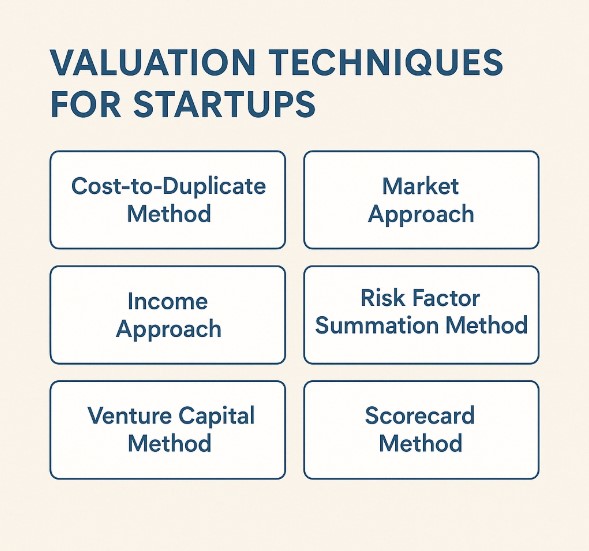
Valuation Techniques for Startups: How to Determine the Right Price
Determining the value of a startup is often more art than science. Unlike established companies, startups lack historical financial data and a steady track record of profits, which makes their valuation more challenging. However, an accurate valuation is crucial for various reasons: securing investment, negotiating mergers or acquisitions, and setting realistic financial goals. In this blog, we explore several key valuation techniques that can help determine the right price for a startup.
Valuing a startup isn’t just about numbers; it’s about understanding its potential to grow, scale, and disrupt. Whether you’re seeking investment or preparing for an exit, having a clear, methodical valuation can be the key to strategic decisions that drive success.
1. The Cost-to-Duplicate Method
This approach is particularly useful for early-stage startups, especially in tech or product-based industries. The cost-to-duplicate method determines how much it would cost to build an exact replica of the startup from scratch. This includes the costs of development, intellectual property, staffing, and other resources. While it may not reflect the true potential of the business, it provides a baseline for valuation when financial data is scarce.
- Pros: Simple and straightforward, Gives an estimate based on tangible assets
- Cons: Ignores the startup’s future revenue potential, Doesn’t account for market or brand value
2. The Market Approach (Comparable Company Analysis)
The market approach compares the startup to similar companies in the same industry that have recently been sold, raised capital, or gone public. This approach uses the valuation multiples (like revenue multiples, earnings multiples, or EBITDA multiples) of comparable businesses to estimate the startup’s worth.
For example, if a similar startup raised funds at a $10 million valuation with $2 million in revenue, the comparable multiple would be 5x revenue. Applying this multiple to the startup’s revenue can provide a ballpark figure.
- Pros: Reflects current market conditions and investor sentiment, Offers a relative perspective based on actual data
- Cons: Difficult to find exact comparables, especially for niche markets, May not fully capture the unique aspects of the startup
3. The Income Approach (Discounted Cash Flow – DCF)
The income approach is based on the startup’s potential to generate future cash flows. In the case of the discounted cash flow (DCF) method, future cash flows are projected and then discounted to the present value using a discount rate that reflects the risk of the business. This method is more suitable for startups that have reached a stage where predictable cash flow patterns are emerging.
- Pros: Focuses on the future earning potential of the startup, Allows for a more detailed and tailored analysis
- Cons: Relies heavily on forecasts, which can be inaccurate for early-stage companies, Requires an understanding of the startup’s financials, which might not always be available

4. The Risk Factor Summation Method
This method takes into account various risk factors that could affect the startup’s success, such as management experience, market risk, competition, technology risk, and other industry-specific risks. The method assigns a risk factor score to each of these elements, which is then used to adjust the startup’s value up or down.
- Pros: A more flexible and holistic approach, Can account for a wide range of external and internal factors
- Cons: Highly subjective and dependent on the evaluator’s judgment, Can lead to inconsistencies if not properly standardized
5. The Venture Capital Method
The venture capital (VC) method is commonly used when valuing a startup at its early stages, especially when it's not yet generating significant revenue. This method involves estimating the future exit value of the startup (such as through an IPO or acquisition) and then working backward to determine the current value. The VC method is particularly popular among investors who are looking for high-growth startups with a potential exit strategy.
- Pros: Focuses on the potential returns for investors, Suitable for high-growth, early-stage startups
- Cons: Highly speculative and depends on the startup’s exit strategy, Can be unrealistic in terms of growth expectations
6. The Scorecard Method
The scorecard method compares the startup to other startups at a similar stage of development, adjusting the value based on a variety of factors such as team experience, market opportunity, product stage, and competition. This method involves scoring these elements and assigning a weight to each factor, ultimately arriving at an adjusted valuation.
- Pros: Provides a more objective analysis based on key startup characteristics, Widely used in the angel investing community
- Cons: Can be subjective depending on how factors are scored, May not fully capture the complexity of the business model
Conclusion
Valuing a startup is never an exact science, but using a combination of these methods can provide a more balanced view of its worth. Each technique has its strengths and weaknesses, and it’s important to consider the stage of the startup, its financial health, market conditions, and growth potential when choosing the right valuation method.
Startups seeking funding or planning an exit should be prepared to justify their valuation to investors or acquirers by using a well-supported methodology. Whether you're an entrepreneur, an investor, or a stakeholder, understanding these valuation techniques can help you make more informed decisions in your business journey.
Valuation is not just about numbers; it’s about understanding the future potential of the business.
